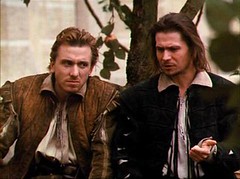Rosencrantz and Guildenstern Are Dead is an absurdist, existentialist tragicomedy by Tom Stoppard, first staged at the Edinburgh Festival Fringe in 1966.[1] The play expands upon the exploits of two minor characters from Shakespeare's Hamlet, says Wikipedia.
Comparisons have been drawn to Samuel Beckett's Waiting For Godot, for the presence of two central characters who almost appear to be two halves of a single character.
Themes:
- Absurdity
The story underlines the irrationality of the world in multiple instances. Stoppard emphasizes the randomness of the world.
- Art vs. Reality
The players help demonstrate the conflict between art and reality. The world in which Rosencrantz and Guildenstern live lacks order. However, art allows people that live in this world, as Stoppard hints that we do, to find order. As the player king says, "There's a design at work in all art."
- Limits of Language
Stoppard mocks language in sequences where the characters fail to express what they are thinking because words cannot exactly capture their thoughts. Instead, they appear ridiculous.
- Insignificance
Rosencrantz and Guildenstern often feel as if they are unable to make any choices that will actually have an impact on their lives. They acknowledge that they must act at the random whims of the other characters, but do not make any effort to fight this lack of control.
- Metatheatre
Metatheatre is a central structural element of Rosencrantz and Guildenstern Are Dead. Metatheatrical scenes, that is, scenes that are staged as plays, dumb shows, or commentaries on dramatic theory and practice, are prominent in both Stoppard’s play and Shakespeare’s original tragedy Hamlet.
Subscribe to:
Post Comments (Atom)





No comments:
Post a Comment